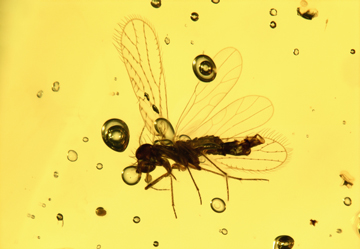Abstract
Amber from the Dominican Republic is famous for the high quality, frequency, and diversity of organic fossils found as inclusions in this mineral (Grimaldi, 1996; Poinar & Poinar, 1999). However, its geological age of origin remains a continuing source of controversy. Over the years a wide variety of age estimates have been made for occurrences of Dominican amber, ranging from Cretaceous (Brouwer & Brouwer, 1982) to Late Eocene (Lambert et al., 1985) to pre-Lower Miocene (Baroni-Urbani & Saunders, 1982). Some authors have also favored a spread of ages that covers much of the Cenozoic (e.g., 40 or 45 Ma to 15 Ma; Poinar & Poinar, 1999). Iturralde-Vinent & MacPhee (1996) attempted to resolve discrepancies in age assignments by taking a multi-pronged analytical approach which yielded a best-fit estimate of mid-Miocene age (20–15 Ma). This estimate has been widely accepted and additionally corroborated by new studies (Iturralde-Vinent, 2001; Ortega-Ariza et al., 2015). However, Braga et al. (2012) have challenged the assessment of Iturralde-Vinent & MacPhee (1996) by arguing for a Pliocene–early Pleistocene date for the amber-bearing Yanigua Formation. Here we address the sources of disagreement and suggest a solution.
References
Alfonso, A., González, E. & Pérez, R. (1994) Climatología de las Tormentas Locales Severas de Cuba: Cronología. Editorial Academia. La Habana, 167 pp.
Álvarez Escudero, L., Borrajero Montejo, I., Álvarez Morales, R., Aenlle Ferro, L. & Bárcenas Castro, M. (2012). Actualización de la distribución espacial de las tormentas eléctricas en Cuba. Revista Cubana de Meteorología, 18, 1, 83–99.
Baroni-Urbani, C. & Saunders, J.B. (1982) The fauna of the Dominican Republic amber: the present status of knowledge. Transactions of the 9th Caribbean Geology Conference, Santo Domingo, Dominican Republic, 1, 213–223.
Bermúdez, P.J. (1950) Contribución al estudio del Cenozoico cubano. Memorias de la Sociedad Cubana de Historia Natural “Felipe Poey”, 19 (3), 204–375.
Bold, W. Van den (1988) Neogene paleontology in the northern Dominican Republic: 7. The subclass Ostracoda (Arthropoda: Crustacea). Bulletin of American Paleontology, 94 (329), 1–79.
Braga, J.C., Díaz de Neira, A., Lasseur, E., Mediato, J., Aguirre, J., Abad, M., Hernaiz-Huerta, P.P., Monthel, J., Pérez-Valera, F. & Lopera, E. (2012) Pliocene–lower Pleistocene carbonates and associated deposits (Fms. Yanigua and Los Haitises) in eastern Hispaniola (Dominican Republic). Sedimentary Geology, 265–266, 182–194.
https://doi.org/10.1016/j.sedgeo.2012.04.007
Brouwer, S.B. & Brouwer, P.A. (1982) Geología de la región ambarífera oriental de la República Dominicana. Transactions of the 9th Caribbean Geology Conference, Santo Domingo, Dominican Republic, 1, 305–322.
Grimaldi, D. A. (1996) Amber: Window to the past. Abrams and American Museum of Natural History, New York, 216 pp.
Iturralde-Vinent, M.A. (2001) Geology of the amber-bearing deposits of the Greater Antilles. Caribbean Journal of Science, 37 (3–4), 141–167.
Iturralde-Vinent, M.A. & MacPhee, R.D.E. (1996) Age and paleogeographic origin of Dominican amber. Science, 273, 1850–1852.
https://doi.org/10.1126/science.273.5283.1850
Kaandorp, R.J.G.,Vonhof, H., Wesselingh, F., Romero Pittman, L., Kroon, D. & van Hinte, J.E., (2005) Seasonal Amazonian rainfall variation in the Miocene Climate Optimum. Palaeogeography, Palaeoclimatology, Palaeoecology, 221 (1), 1–6.
https://doi.org/10.1016/j.palaeo.2004.12.024
Lambert, J.B., Frye, J.S. & Poinar, G.O. (1985) Amber from the Dominican Republic: Analysis by nuclear magnetic resonance spectroscopy. Archeometry, 27, 43–51.
https://doi.org/10.1111/j.1475-4754.1985.tb00345.x
Li, C., Jones, B. & Blanchon, P. (1997) Lagoon-shelf sediment exchange by storms--evidence from foraminiferal assemblages, east coast of Grand Cayman, British West Indies. Journal of Sedimentary Research, Section A: Sedimentary Petrology and Processes, 67 (1), 17–25.
https://doi.org/10.1306/D42684DC-2B26-11D7-8648000102C1865D
Mao, Y.Y., Liang, K., Su, Y.T., Li, J.G., Rao, X., Zhang, H., Xia, F.Y., Fu, Y.Z., Cai, C.Y., Huang, D.Y., (2018) Various amberground marine animals on Burmese amber with discussions on its age. Palaeoentomology, 1 (1), 91–103.
https://doi.org/10.11646/palaeoentomology.1.1.11
Poinar, G.Jr. & Poinar, R. (1999) The amber forest, a reconstruction of a vanished world. Princeton University Press, Princeton, 292 pp.
Serra-Kiel, J., Ferràndez-Cañadell, C., García-Senz, J., Hernaiz Huerta, P.P. (2007) Cainozoic larger foraminifers from Dominican Republic. Boletín Geológico y Minero, 118 (2), 359–384.
Sherratt, E., del Rosario Castañeda, M., Garwood, R.J., Mahler, L.D., Sanger, T.J., Herrel, A., de Queiroz, K. & Losos, J.B. (2015) Amber fossils demonstrate deep-time stability of Caribbean lizard communities. Proceedings of the National Academy of Science, U.S.A., 112 (32), 9961–9966.
https://doi.org/10.1073/pnas.1506516112
Tsuchi, R. (1990) Pacific Neogene events; their timing, nature and interrelationships. University of Tokyo Press, 206 pp.
Van den Bold, W. (1988) Neogene paleontology in the northern Dominican Republic: 7. The subclass Ostracoda (Arthropoda: Crustacea). Bulletin of American Paleontology, 94 (329), 1–79.
Wynn Jones, R. (2006) Applied palaeontology, Cambridge University Press, 421 pp.1969
You, Y., Huber, M., Müller, R.D., Poulsen, C.J. & Ribbe, J. (2009). Simulation of the Middle Miocene Climate Optimum. Geophysical Research Letters, 36, L04702. 5 pp.
https://doi.org/10.1029/2008GL036571
Yu T.T., Kelly, R., Mu, L., Ross, A., Kennedy, J., Broly, P., Xia, F.Y., Zhang, H.C., Wang, B. & Dilcher, D. (2019) An ammonite trapped in Burmese amber. Proceedings of the National Academy of Science, U.S.A., 116 (23), 11345–11350.
https://doi.org/10.1073/pnas.1821292116
Zorn, I. (2004). Ostracoda from the lower Badenian (middle Miocene) Grund Formation (molasse basin, lower Austria). Geologica Carpathica, 55 (2), 179–189.

